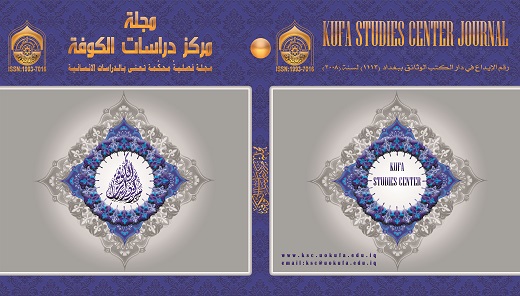إشكاليات وحلول ترجمة معاني النص القرآني
DOI:
https://doi.org/10.36322/jksc.v1i50.5323Abstract
لكي تكون الحجة البالغة لله على جميع خلقه, فإن ذلك يقتضي البلاغ والبيان لقوله تعالى (وَأُوحِيَ إِلَيَّ هَذَا الْقُرْآَنُ لِأُنْذِرَكُمْ بِهِ وَمَنْ بَلَغَ) عملاَ بقاعدة قبح العقاب من غير بيان فيترتب على ذلك أن القرآن الكريم لا يختص في موضوعاته بأمة من الأمم كالأمة العربية مثلا ، كما لا يختص بطائفة من الطوائف كالمسلمين بل يوجه خطابه إلى غير المسلمين كما يتكلم مع المسلمين . وقد احتج القرآن الكريم على كل البشر ودعاهم إلى الدين من دون أن يقيد الخطاب بالعرب، ومؤدى ذلك أحد امرين. فإما أن يتكلم جميع البشر بلغة العرب ليفهموا مراد الله تعالى من كتابه الكريم. وإما أن تترجم معاني الفاظ القرآن الكريم الى لغة الأقوام من غير العرب ليصلهم البلاغ الذي أمر الله تعالى نبيه الكريم لينذر به الناس.
ولما كان الأمر الأول محالا لاختلاف السنة الناس بقي الأمر الآخر وهو ترجمة معاني الألفاظ القرآنية الى اللغات الأخرى . ولكن ترجمة النص القرآني الكريم الى تلك اللغات تحيط بها مجموعة من المحاذير الشرعية عند نسبة النصوص المترجمة الى الله تعالى, كما أن هناك محاذير موضوعية تكتنف الترجمة لما تنماز به اللغة العربية من خصوصية في التركيب والدلالة واكتناز المعاني والتصريف دون سائر اللغات حتى اختارها الله تعالى لغة لكتابه العزيز. فيجب من الترجمة أن تترجم المعاني دون الألفاظ لاستحالة ذلك باستحالة النسبة, كما يجب على المترجم أن يتصف بخصوصيات تؤهله للقيام بهذه المهمة جاء البحث على ذكرها كشروط واجبة التوفر عند من يريد ترجمة معاني القران وكان منها المعرفة الدقيقة بمباحث اللغة والبيان والتمكن من مباحث علوم القرآن.
Based on the principle of universality of the meaning of the Holy Quran in his speech and the reporting of his provisions; which is referred to by the Holy Quran itself and in no place. And the need to communicate and communicate a text and a reference to all people and his statement to them. It was necessary to find a way to preserve the identity and spirit of the text and its significance when it is delivered to non-speakers of the language of the Koran, and by finding the linguistic equivalent between the language of the Koran and the language of non-Arab peoples, The Qur'anic language, making the translation a way to reach the clarification and statement of the Koranic text of the non-Arab.
But the translation of the signs of the Koranic text occurred under the dispute between scholars and translators and linguists; between leave and prevention in view of the nature of the Quranic text miraculous in its construction and the method of regularity of its verses, and the opening of the semantic and interpretive interpretation of the words and meanings, and the vocabulary of these meanings and multiple meanings multiplied by the fact that the Koran port Faces.
The method of translation of the Quranic text has also objected to many problems which must be sought for solutions, especially since the translation of this sacred text has been on several levels. Hence, there was no single level of translation that had an implication on the meaning of that word, It was at the level of the word significant significance of the meaning of that word, including what was at the level of the word is meaningful commitment to the meaning or meaning of the avoidance of that word to find multiple evidence. The significance of the context, the significance of the sentence, and the other rhetorical indications, and then to consider important questions such as the question of participation, the question of tandem, deletion and appreciation ...
And some of these problems were not to emerge from the translation, but instead of what is the subject of disagreement between Muslim scholars and their thinkers within the text and the difference of the Arab concept, although it is what is the difference of multiplicity, no difference of contrast, but it contributes to open the field in front of the researcher in meaning to stand puzzled in any Meanings and the subsequent reports take in the translation. In addition to the problem of how to translate between the level of translation of vocabulary and the level of translation of sentences, while there is no prima facie in the two halves of translation. In all of this, it is necessary to note the conditions available to the translator, noting the linguistic and religious culture of the translator.
Downloads
Downloads
Published
How to Cite
Issue
Section
License
Copyright (c) 2022 مجلة مركز دراسات الكوفة | Journal of Kufa Studies Center

This work is licensed under a Creative Commons Attribution 4.0 International License.
Permit others to distribute and copy the manuscript, to create extracts, abstracts, and other revised versions, adaptations, or derivative works of or from the manuscript (such as a translation), to include in a collective work, to text or data mine the article, even for commercial purposes, as long as they credit the author(s), do not represent the author as endorsing their adaptation of the article, and do not modify the article in such a way as to damage the author''''s honor or reputation. Further details are found at Creative Commons Attribution 4.0 International (CC BY 4.0)






























